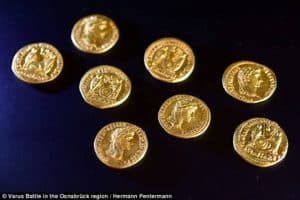- Eight gold coins were discovered at Kalkriese archaeological site, Germany
- Researchers say they were likely dropped in battle, or hidden intentionally
- Coins feature Emperor Augustus on front, and Gauis and Lucius on back
Eight gold coins discovered during an archaeological excavation in Germany could confirm the site of the legendary Battle of Teutoburg Forest.
Such a find is extremely rare, the researchers say, and this recent discovery at Kalkriese expands the number of gold coins collected at the site by more than double the previous amount.
The coins featured images of the Emperor Augustus, with the imperial princes Gaius and Lucius Caesar on the back, and all date back to a period before the ancient battle.

In just six weeks of digging this season, archaeologists have uncovered mounting evidence that indicates Kalkriese was once the site of the ancient battlefield, according to Forbes.
Roughly 18,000 men were killed during the slaughter in Teutoburg Forest in 9C, when German tribes led by Arminius ambushed three Roman legions.
At the time, the Roman soldiers were led by the general Varus.
Kalkriese lies in the district of Osnabrück, Lower Saxony, Germany, and the coins were found along with pieces of Roman military equipment and bronze coins.
Researchers from the University of Osnabrück and Kalkriese, who led the dig, say the discovery of the eight gold coins is one of ‘extraordinary’ luck.
All are in a good state of preservation, though some show significant traces of use.
The team discovered the coins – called ‘aurei’ – all within a few meters of each other, indicating a coin purse was likely dropped to the ground in the course of fighting, or intentionally hidden.
These coins were minted between 2BCE and 5CE, and the archaeologists speculate they once belonged to an officer or higher-ranking Roman soldier.
These coins would have been of considerable value, they say, and before the most recent discovery, only seven gold coins had been found at the ancient battlefield.
An aureus from the reign of Emperor Augustus would have been enough to feed an entire family in Rome for a month, the researchers say, and so a small purse-full as what decorated the land could have provided for its owner for upwards of a year.
Gaius and Lucius are pictured on the back of the coins, each carrying a lance, shield and a curved religious staff known as ‘lituss.’
They stand mirroring each other, and the researchers say this imagery has both military and religious allusions for the two princes, who were designated successors of Augustus.
The archaeologists say this the discovery raises new questions about the massacre, and indicate that there is still a need for more research at the site of the battlefield.
With each new find, the researchers are better able to understand what really happened, ‘little by little.’
Click the link below to find our more.
http://www.dailymail.co.uk/sciencetech/article-3670663/Eight-gold-coins-discovered-Germany-mark-site-ancient-Roman-massacre-archaeologists-say.html#ixzz4sKnBfVBm
Credits: CHEYENNE MACDONALD FOR DAILYMAIL.COM

